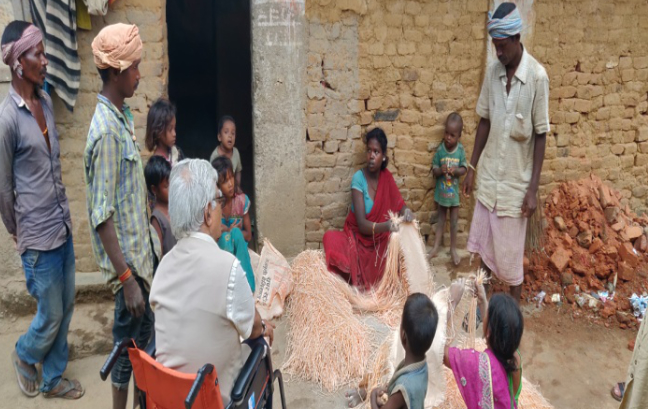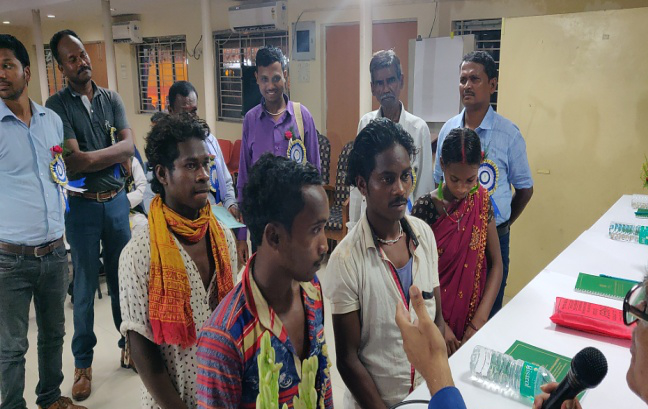Thus despite having constitutional safeguards and targeted welfare programs, schemes, dedicated financial provisions and institutions, compared to the general population the tribal population lag far behind in the Human Development Index (HDI). The natural resource base of the landscape forms the foundation of the tribal livelihood and means to improve their HDI . The fundamental need for survival and sustainable human development of any rural tribal community requires conservation and better management of the natural resource like the forest, water, livestock and soil as interdependent components of the ecosystem. This requires integrated landscape management
Unlike issue-based Tribal Development approaches, IBRAD has been working through the approaches to the Sustainable Tribal Development in the framework of SDGs ( Sustainable Development Goals). IBRAD’s approaches to Sustainable Tribal Development focus upon developing the capacity of the tribal community with a particular focus on women and youth, to develop appropriate social norms and institutions for conservation of the natural resources, community empowerment and community-led social actions for conservation-based sustainable livelihood developments
-
The challenges become manifold under the context of the climate change that further increases the vulnerability of the tribal community. The approach of Sustainable Tribal Development contributes towards achieving the goals of ‘No Poverty (SDG 1) and Zero Hunger (SDG 2)’. In a way, it requires action for reducing poverty, improving health and livelihoods, and enhancing the resiliency of vulnerable communities. We consider the poverty is not merely lack of income or wealth, rather poverty is seen as multi-dimensional. Poverty may be encompassing material deprivation, the lack of access to other basic needs for health, well-being ( SDG -3), nutrition and food security, the lack of political autonomy and empowerment, as well as the lack of freedom of choice and social inequality.
IBRAD has launched a number of measures to develop nutrition organic kitchen gardens, planting fruit trees to end hunger ( SDG-2) and ensure access by the tribal people, in particular, the poor and people in vulnerable situations, including infants, to safe, nutritious and sufficient food all year round. Health awareness camps will help connecting the community with the Public Health Centre ( PHC ) or the sub-center to control preventable deaths of newborns and children under, 5 years of age aiming to reduce neonatal mortality and improve the community well-being ( SDG-3).
-
The conservation of biodiversity, soil and water benefits tribes in the area of sustainable livelihood . Not only that biodiversity and fruit trees then conjectured to be more important for the poor as they provide a cost effective insurance policy against the risk of food insecurity to the tribes that do not have alternative risk coping mechanisms. This requires to create awareness and quality education skill development ( SDG-4) to ensure that Tribal community, in particular, the poor and the vulnerable PVTGs, have developed competency to understand the value of conservation as well as their rights to basic services, ownership, and control over land and other forms of property, inheritance, natural resources, appropriate new technology, and financial services, including microfinance. IBRAD has developed “ Prashikshan Shivir and designed the courses based on the crop calendar in the pattern of ‘Farmers Field School’ for inclusive and equitable quality education. Skill development, transfer of appropriate technology, promote and practice lifelong learning opportunities (SDG-4). The project for Women Empowerment has helped the family to appreciate the judicious gender roles and provide women ( SDG-5) with economic resources, as well as access to ownership and control natural resources, financial services, , in accordance with national policy of the Joint Forest Management. Such endeavor has helped women’s full and effective participation and equal opportunities for leadership at all levels of decision-making in political, economic and public life. Training with the enabling technology related to organic farming, agri-business, in particular, helped the empowerment of women. The introduction of organic farming has been helping to improve water quality by reducing pollution, minimizing the release of hazardous chemicals and materials. Introduction of drip irrigation and rainwater harvesting improve the water-use efficiency in village-like Jhargram and ensure sustainable use of freshwater ( SDG-6). Awareness of the protection and restoration of the water-related ecosystems, forests, wetlands, the aquifer has been a continuous process in the project area of the Tribal Landscapes. Sustainable harvesting of the forest resources to ensure sustainable consumption and production patterns (SDG -12) has been implemented under the Joint Forest Management Program jointly with the state Forest Department. Further, attempts will be made to develop and implement tools and Criteria and Indicators to monitor sustainable forest management and study the impacts.
-
Tribal communities are vulnerable to climate change and need adaptation strategies that will protect health of the community and health of natural forest mosaic landscape ecosystem. It requires the understanding of not only the climate vulnerability and assessments but also creating awareness, building capacity of the tribal and the co existing community for developing and implementing tribal climate change adaptation based sustainable livelihood.
Strategic plan has been designed to improve education, awareness-raising and building institutional capacity on climate change mitigation, adaptation, impact reduction and early warning for sustainable agriculture as an action to combat climate change and its impacts (SDG-13). A team of proactive leaders has been engaged for raising capacity for effective climate change-related planning and management and monitoring
IBRAD has been involved in developing the strategy through community participation for protection, restoration to promote sustainable use of terrestrial ecosystems, sustainably manage forests and halt and reverse land degradation and halt biodiversity loss. It facilitates in strengthening the socio-ecological processes not only for promoting conservation and sustainable livelihood but also mainstreaming of the tribal community through capacity development, exposure visits and integrating the tribal community with other social groups through participatory actions.Such process of mainstreaming improves the social relation, social cohesion, and dignity of the tribal community. The empowered tribal community takes part in the mainstream development process that helps in inclusive growth and reduction of inequality.
-
There is considerable evidence from the ecology and agronomy literatures on the relationship between agro-biodiversity and crop productivity, variability and yield shocks. For example, diverse crop species are shown to adapt better to environmental changes since the larger pool of different metabolic traits and metabolic pathways enables them to more effectively use resources such as water and soil nutrients over a broad range of environmental conditions. The conservation of agro-biodiversity, as seed bank can safe guard the Tribal community against negative environmental effects and support the resilience of the system under adverse weather conditions associated with climate change. Therefore, there is need to protect, restore and promote sustainable use of terrestrial ecosystems, sustainable forest management reverse land degradation and halt biodiversity loss Goal 15.



